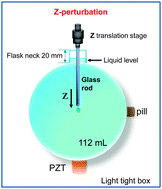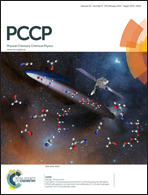Single bubble perturbation in cavitation proximity of solid glass: hot spot versus distance†
Abstract
A systematic study of the energy loss of a cavitation bubble in a close proximity of a glass surface is introduced for the first time in a low acoustic field (1.2–2.4 bar). Single bubble sonoluminescence (SBSL) is used as a tool to predict the temperature and pressure decrease of bubble (μm) versus surface distance. A glass as a model system is used to imitate the boundary conditions relevant for nano- or micromaterials. SBSL preequilibrated with 5% argon is perturbed by a glass rod with the tip (Z-perturbation) and with the long axis (X-perturbation) at a defined distance. From 2 mm to 500 μm argon-SBSL lines monotonically narrow and the effective emission temperature decreases from 9000 K to 6800 K comparable to multiple bubbles. The electron density decreases by two orders of magnitude in Z-perturbation and is by a factor of two higher in X-perturbation than the unperturbed cavitating bubble. The perturbed single bubble sonoluminescence pressure decreases from 2700 atm to 1200 atm at 2.4 bar. In water new non-SBSL SiO molecular emission lines are observed and OH emission disappears.


 Please wait while we load your content...
Please wait while we load your content...